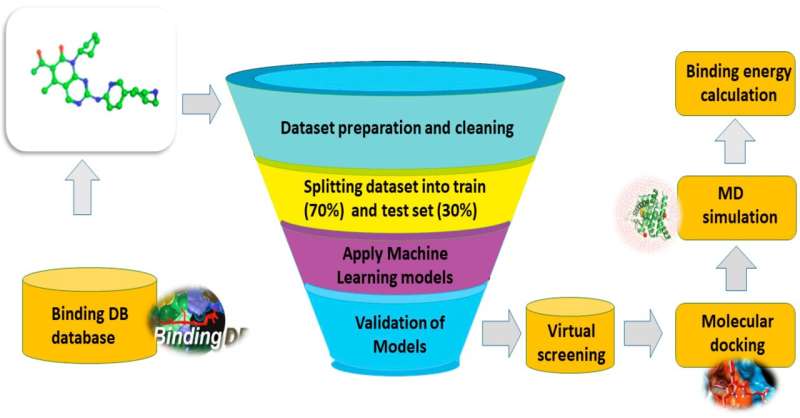This article has been reviewed according to Science X's editorial process and policies. Editors have highlighted the following attributes while ensuring the content's credibility:
fact-checked
proofread
Chemists used machine learning and molecular modeling to identify potential anticancer drugs

RUDN University chemists and colleagues from China built several machine learning models and discovered a group of potential drugs that inhibit the enzyme responsible for uncontrolled cell division. The results were published in Biomedicines.
Cyclin-dependent kinase 2 (CDK 2) is an enzyme that participates in the regulation of cell division. Although CDK 2 is not essential in healthy cells, it has a crucial role in the uncontrolled growth of cancer cells. Inhibiting the activity of CDK 2 restrains tumor growth, so it is important to find effective CDK 2 inhibitors. RUDN University chemists and colleagues from China combined computer research methods for this: machine learning and molecular modeling. As a result, chemists were able to discover several potential inhibitors.
"Cyclin-dependent kinase 2 is a promising target for cancer treatment. The development of its inhibitors is important in antitumor therapy. The participation of this enzyme in tumor formation remains incompletely studied, but it is already clear that its inhibition is useful in the treatment of cancer. Several inhibitors have already undergone clinical trials, but a selective inhibitor specifically for this enzyme has not yet been found," said Alexander Novikov, Ph.D. in Chemistry, senior researcher at the Joint Institute of Chemical Research of RUDN University.
To find a candidate drug, chemists used machine learning methods. The authors built several models to find active inhibitors of CDK 2. The chemists built a molecular model using the molecular docking method, which can identify the most favorable molecular orientation for the formation of a stable complex.
Machine learning models identified 25 potential active CDK 2 inhibitors with 98% accuracy. Chemists tested each of them using molecular docking. Three substances worked best. For the top three, a computer simulation was built using the molecular dynamics method and compared with the reference compound dalpiciclib. All three turned out to be more stable and more compact.
"Compared to the control drug dalpiciclib, the three calculated compounds showed more stable behavior and compactness. Despite the promising results, our study has several limitations. We need in-depth clinical trials in vitro and in vivo to confirm inhibitory activity and potential therapeutic efficacy. In addition, when developing drugs, it will be necessary to study the effect of compounds on off-target interactions and their toxicity," Alexander Novikov, Ph.D. in Chemistry, senior researcher at the Joint Institute of Chemical Research of RUDN University.
More information: Muhammad Shahab et al, Machine Learning-Based Virtual Screening and Molecular Simulation Approaches Identified Novel Potential Inhibitors for Cancer Therapy, Biomedicines (2023). DOI: 10.3390/biomedicines11082251
Provided by Russian Foundation for Basic Research




















